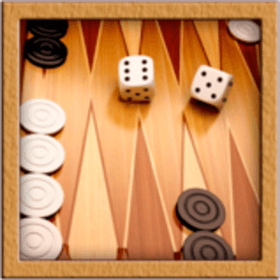Backgammon
 Backgammon is one of the oldest known board games.
Backgammon is one of the oldest known board games.
The goal is to move checkers around, then off the board. The first player to get all of their checkers off the board wins.
On your turn, you roll 2 dice, and you can make 2 moves accordingly. You can only move on free positions, meaning positions that are not occupied by 2 or more of your opponent's checkers.
Number of players: 2
Game duration: 16 mn
Complexity: 1 / 5
Play Backgammon and 1194 other games online.
No download necessary - play directly from your web browser.
With your friends and thousands of players from the whole world.
Free.

Play Backgammon and 1194 other games online.
No download necessary - play directly from your web browser.
With your friends and thousands of players from the whole world.
Free.

Rules summary
Objective
Players roll dice to advance their pawns into their home base. When completed, players resume by rolling dice to remove their pawns from the board. A player's pawns may not be removed from the board until all of their pawns are in their home base. First player to clear all pawns from the board wins. Exact roll is not required to remove pawns from the board, roll can be equal to or more than the amount of spaces required to leave the board.
Setup
The game has a fixed setup, with opponent mirrored arrangement. Each players home row is opposite the other, and each will be moving in only one, opposite direction around the board (either clockwise or counter-clockwise).
Play
Each roll of two dice can be played to advance one pawn both numbers, the order chosen by the player, or split play as each die to advance one pawn respectively. Should any number roll as double, player is able to play that number four times, as board will allow. pawns cannot be moved to land on any space occupied by two or more opposing pawns. Your own pawns may accumulate in any quantity on your own occupied spaces.
Capture
Any pawn stacked two or more is safe from capture. Any pawn single on a space is vulnerable. Rolling number combination to land your pawn on exposed opponent pawn is a capture and token must sit out of play until a number roll allows entry into opposing home row (i.e farthest from own). No other pawn may be moved until all captured pawn have re-entered the game.
Doubling
Backgammon games are played for 1 point. Matches are played with multiple points. When in Match play, if one opponent feels their game is so strong that they will most likely win, they "offer the cube" to the other opponent. The other opponent can then accept (in which case the game is worth double the current stakes) or decline (and the game ends in their loss). If a player accepted the cube, and their situation later improves, they can then "double", if they so desire. Players may go back and forth doubling in this way, but doubling more than 2 or 3 times in one game is very rare.
Match Play
A Match of Backgammon involves several games worth 1-3 points until a player equals to or exceeds the Match Goal. The Doubling cube multiplies the number on the cube by the points earned to give the total match points earned that game.
The points awarded depend on the scale of the victory as follows:
1 point - A player who bears off all fifteen checkers when the opponent has borne off at least one.
2 points - If all fifteen have been borne off before the opponent gets at least one checker off. This is called a gammon or double game.
3 points - When the losing player has borne off no checkers and has one or more on the bar and/or in the winner's home table. This is called a backgammon or triple game.
In the variant "Hypergammon" the Jacoby Rule has been implemented: Gammons and backgammons score extra points only if one of the players has doubled beforehand.

